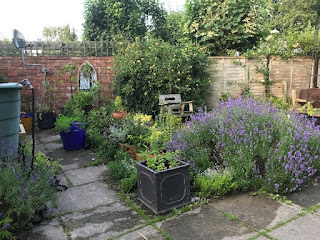Day 8
Housekeeping first.
The site only shows the most recent blogs and it is not immediately obvious how to access the earlier ones. Here is a guide.
In the top left hand corner you will find the menu icon :
Click on and you will reach the profile page. In the bottom left hand corner, in the tiniest script you will find ARCHIVE.Click on and you will be able to see the earlier blogs.
Today’s Book
London Rules
This book starts with one of the most shocking/surprising/unexpected openings that I have read in a long time and the rest of the book lives up to it.
I love Mick Herron’s Jackson Lamb books, and while you can read this as a stand-alone novel, your experience and enjoyment of it will be much stronger if you have read the previous four. Briefly, Jackson Lamb runs Slough House where MI5 agents who have made major mistakes are sent – too dangerous (inept) to keep on the strength, too dangerous(perhaps not inept enough) to sack. Slough House is dysfunctional and Jackson Lamb is perhaps the most dysfunctional member of it and although preternaturally lazy, he does not like being left out of things.
An atrocity has occurred, followed closely by another. The PM feels vulnerable, threatened on all sides by populists, nationalists, the press – some of whom just might seem vaguely familiar. He seeks the help and advice of MI5’s First Desk, Claude Whelan, stirring up all sorts of factions within MI5 . . .
This is, at the same time, a good thriller and a very funny book. Herron manages to balance the two perfectly. He is the master of the brief throw -away line that tells you everything you need to know: He kept a bottle of champagne in the fridge for just such an occasion. It wasn’t vintage at least not when he bought it.
So, if you haven’t read any of his books before, start with Slow Horses and then the rest. Each book improves on the former. If you have read them you won’t have bothered reading this because you will already be stuck into London Rules.
Today's Music
Richard Strauss : Duett Concertino F-dur, clarinet: Thorsten Johanns bassoon:Ole Kristian Dahl
https://www.youtube.com/watch?v=ym3JVzD_1Q8
Food
One for Jo and one for Sarah
Chocolate Mousse
(4 small portions)
· A block of good plain chocolate 65%+ (the higher the better)
· The whites of 2 eggs whipped stiff
· At least 300ml double cream whipped (300mls makes a very strong & chocolatey mousse which can be quite bitter. 450ml is probably best)
Method
1. Melt the chocolate over hot water with a teaspoon of liquid (water, brandy, whisky, sherry, rum – your choice)
2. Let the chocolate cool slightly (5 minutes)
3. Transfer to serving dish
4. Fold the cream gently into the chocolate
5. With a metal spoon fold the beaten white into the chocolate mixture. Lose as little air as possible.
Additions
· Booze
· Orange or lemon zest
· Glace or crystalised ginger
· Serve over cherry compote
Add lots of good cream
A
Dahl, dal, dhal . . .
Essentially dahl is a pot of pulses cooked until they are soft. An excellent food, vegetarian, easily digested, full of protein and roughage – and you can do an infinite number of things with it.
You can buy the pulses in tins or dried. If you are using the dried, soak them in cold water before cooking. The longer you soak them the shorter the cooking time. The theory is that the dried versions taste better, but the quality of the tinned varieties has improved a lot recently.
This is the recipe that I make most often. I vary the spices according to my mood.
Ingredients
300gm split peas
A handful of red lentils
300mls stock or water
1 chopped onion
2 chopped cloves of garlic
1 cm of ginger, chopped
1 tin of tomatoes or 250gm chopped fresh tomatoes
1 coarsely chopped pepper
1 finely chopped chilli
Spices – I usually use a mixture of ground cumin, coriander, black pepper, allspice. If I feel in need of a shock to the system I add paprika and chilli. Basically, experiment.
Chopped fresh coriander (cilantro) or parsley
Salt to season.
1. Place all the ingredients, except the fresh herbs and the salt, in a large saucepan and bring to the boil.
2. Lower the heat to its lowest setting and leave pot to simmer, stirring every now and then to check it’s not sticking. (You can also use a slow cooker if you wish. Depending on the brand, it will take about 4 hours.)
3. When the split peas are soft (usually 1 1/2 - 2 hours) and the mixture is the consistency you want (It can vary from a soup to sloppy mash potato – your choice. If you want a soup, leave out the lentils.) remove from the heat.
4. Add the chopped fresh herbs and stir well.
5. Taste and add salt and more black pepper if needed.
It tastes delicious just as it is, but because I always make far too much for one serving, I vary the way I serve it.
1.
Serve it in a
small oven proof dish. Make a dent in the centre of the dahl. Break an egg into
the dent. Cook in the oven (180c) until the white is set. Eat with toast soldiers or bread sticks.
2. Serve in a bowl, again make a dent in the dahl and spoon in a mixture of cream cheese or yogurt, chopped peppers, chilli, chives, tomatoes (chopped very small). Eat, using flat bread as a spoon.
3.
Serve in a bowl,
again make a dent in the dahl and spoon in a dollop of very cold butter or grated cheese.
4. Use as an accompaniment (think exciting mash) to sausages, egg and bacon, hamburgers, chops etc
5. If you want to vary the texture you can garnish it with crisp bacon strips, nuts, lardons etc
It is the most amazing comfort food – almost eclipsing mashed potato and gravy – and it is a healthy option. Perfect.
Today's Painting
The Arnolfini Marriage by Jan van Eyck (1434)
82 cm x 60 cm. Look at the detail of the convex mirror image itself:















Comments
Post a Comment